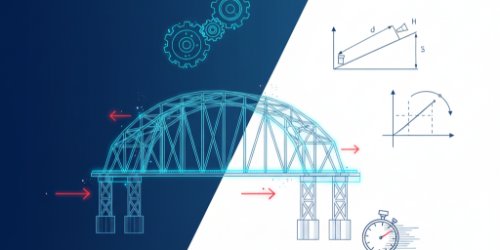Moments of Inertia - Engineering Mechanics (Undergraduate Advanced)
17
3 hrs
 MEE 205: Engineering Mechanics - StaticsMaster the science of structural stability. This programme provides a complete education in engineering statics, covering the analysis of forces, moments, and equilibrium in rigid bodies. It delivers the non-negotiable principles required to design safe and reliable structures.
This learning track is for first or second-year undergraduate students in Civil, Mechanical, Aerospace, and Structural Engineering. It is the foundational mechanics course upon which all subsequent design and analysis subjects are built.
Analyse the forces within any static structure, from simple trusses to complex machines. You will master free-body diagrams, equilibrium equations, and structural analysis methods. This programme equips you with the core analytical skills for a career in structural, mechanical, or civil design.
MEE 205: Engineering Mechanics - StaticsMaster the science of structural stability. This programme provides a complete education in engineering statics, covering the analysis of forces, moments, and equilibrium in rigid bodies. It delivers the non-negotiable principles required to design safe and reliable structures.
This learning track is for first or second-year undergraduate students in Civil, Mechanical, Aerospace, and Structural Engineering. It is the foundational mechanics course upon which all subsequent design and analysis subjects are built.
Analyse the forces within any static structure, from simple trusses to complex machines. You will master free-body diagrams, equilibrium equations, and structural analysis methods. This programme equips you with the core analytical skills for a career in structural, mechanical, or civil design.
Master the science of structural stability. This programme provides a complete education in engineering statics, covering the analysis of forces, moments, and equilibrium in rigid bodies. It delivers the non-negotiable principles required to design safe and reliable structures. This learning track is for first or second-year undergraduate students in Civil, Mechanical, Aerospace, and Structural Engineering. It is the foundational mechanics course upon which all subsequent design and analysis subjects are built. Analyse the forces within any static structure, from simple trusses to complex machines. You will master free-body diagrams, equilibrium equations, and structural analysis methods. This programme equips you with the core analytical skills for a career in structural, mechanical, or civil design.
 GET 207: Applied MechanicsMaster the non-negotiable principles of Engineering Mechanics. This track delivers a rigorous, complete programme in statics and dynamics, built to the NUC GET 207 core curriculum. It moves methodically from force systems and equilibrium to the kinematics of rigid bodies and the kinetics of particles. This is the foundation of all structural and mechanical analysis.
This programme is for first and second-year undergraduate engineering students. It is an essential requirement for students in Mechanical, Civil, Structural, Aerospace, and Mechatronics engineering. A working knowledge of introductory physics and calculus is assumed.
On completion, you will be able to analyse and solve complex problems in statics and particle dynamics. You will draw free-body diagrams, apply equilibrium equations, analyse trusses and frames, and solve motion problems using Newton's laws, work-energy, and momentum methods. This programme prepares you for advanced courses, particularly Mechanics of Materials, and future professional engineering practice.
GET 207: Applied MechanicsMaster the non-negotiable principles of Engineering Mechanics. This track delivers a rigorous, complete programme in statics and dynamics, built to the NUC GET 207 core curriculum. It moves methodically from force systems and equilibrium to the kinematics of rigid bodies and the kinetics of particles. This is the foundation of all structural and mechanical analysis.
This programme is for first and second-year undergraduate engineering students. It is an essential requirement for students in Mechanical, Civil, Structural, Aerospace, and Mechatronics engineering. A working knowledge of introductory physics and calculus is assumed.
On completion, you will be able to analyse and solve complex problems in statics and particle dynamics. You will draw free-body diagrams, apply equilibrium equations, analyse trusses and frames, and solve motion problems using Newton's laws, work-energy, and momentum methods. This programme prepares you for advanced courses, particularly Mechanics of Materials, and future professional engineering practice.
Master the non-negotiable principles of Engineering Mechanics. This track delivers a rigorous, complete programme in statics and dynamics, built to the NUC GET 207 core curriculum. It moves methodically from force systems and equilibrium to the kinematics of rigid bodies and the kinetics of particles. This is the foundation of all structural and mechanical analysis. This programme is for first and second-year undergraduate engineering students. It is an essential requirement for students in Mechanical, Civil, Structural, Aerospace, and Mechatronics engineering. A working knowledge of introductory physics and calculus is assumed. On completion, you will be able to analyse and solve complex problems in statics and particle dynamics. You will draw free-body diagrams, apply equilibrium equations, analyse trusses and frames, and solve motion problems using Newton's laws, work-energy, and momentum methods. This programme prepares you for advanced courses, particularly Mechanics of Materials, and future professional engineering practice.
Course Chapters
1. Introduction2
2. Moments of Inertia of Areas (1)
Analysis of rectangular and polar moments of inertia and radius of gyration of areas by direct integration.
No lesson yet.
3. Moments of Inertia of Areas (2)
Analysis of rectangular and polar moments of inertia and radius of gyration of composite areas using those of their component areas.
No lesson yet.
4. Products of Inertia of Areas
Analysis of products of inertia, principal axes and principal moments of inertia of areas, by direct integration and also using those of component areas.
No lesson yet.
5. Mohr's Circle for Moments of Inertia of Areas
Analysis of moments and products of inertia of areas using Mohr's circle.
No lesson yet.
6. Mass Moments of Inertia (1)
Determining mass moments of inertia and radius of gyration of three-dimensional bodies by direct integration.
No lesson yet.
7. Mass Moments of Inertia (2)
Determining mass moments of inertia and radius of gyration of composite three-dimensional bodies using those of component shapes.
No lesson yet.
8. Mass Products of Inertia
Analysis of mass products of inertia, principal axes and principal moments of inertia using those of component parts.
No lesson yet.